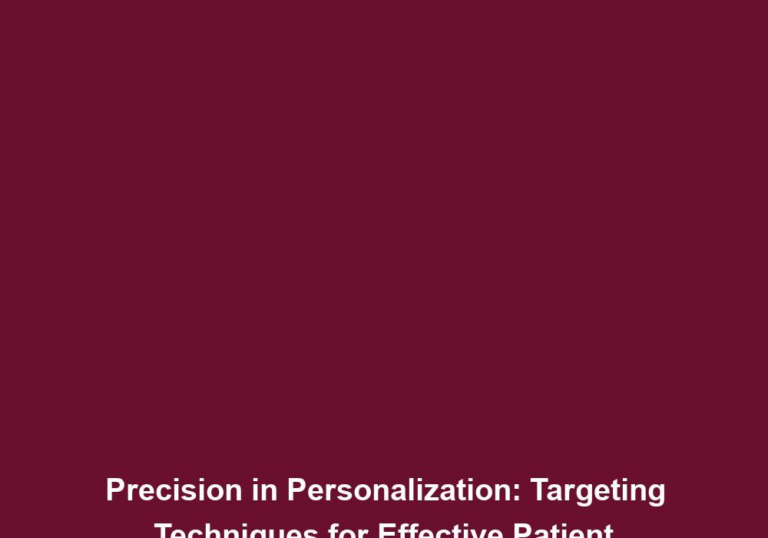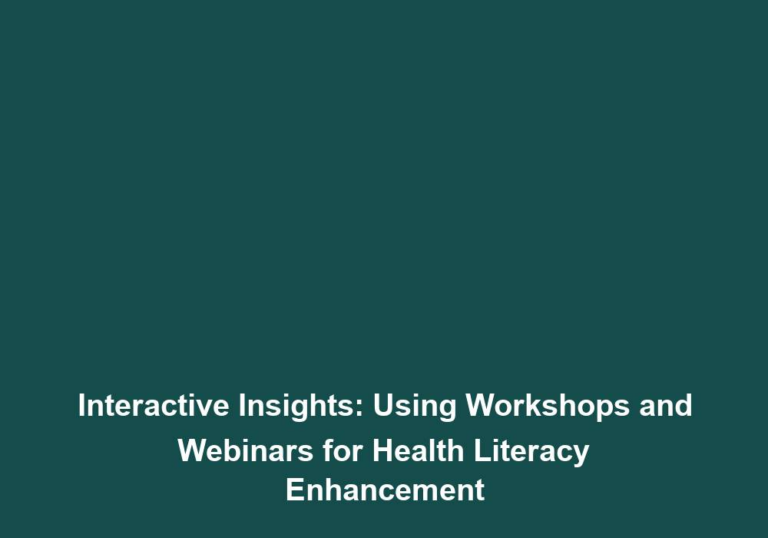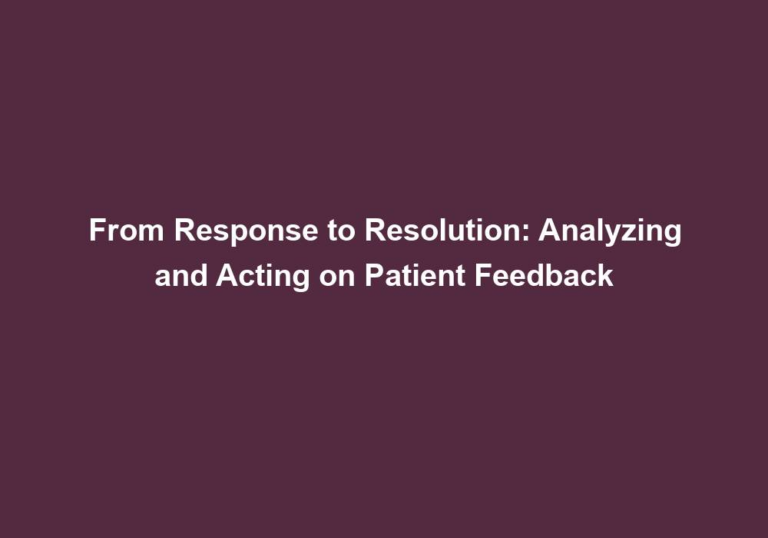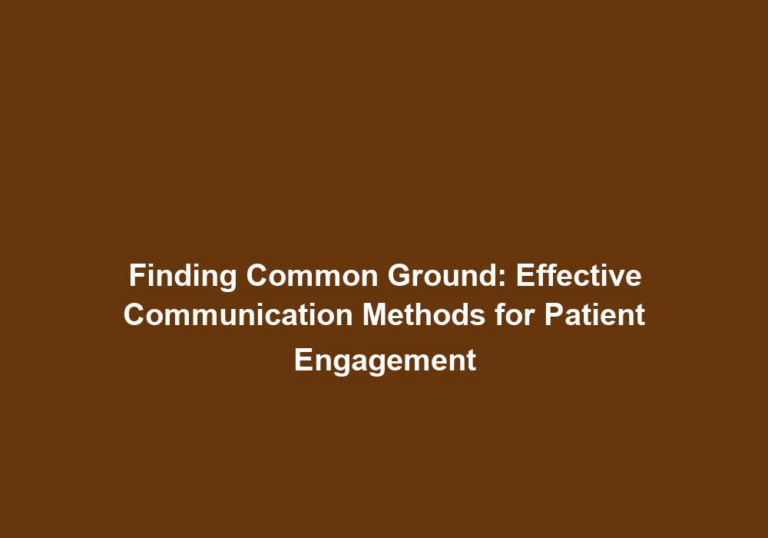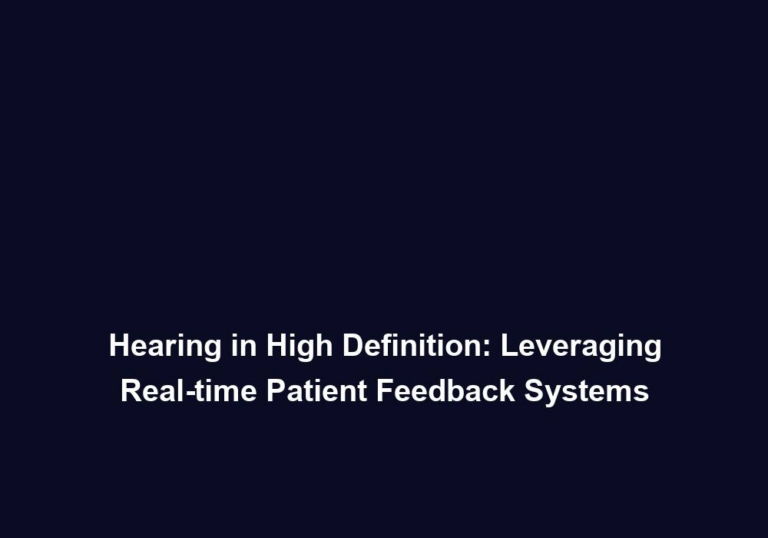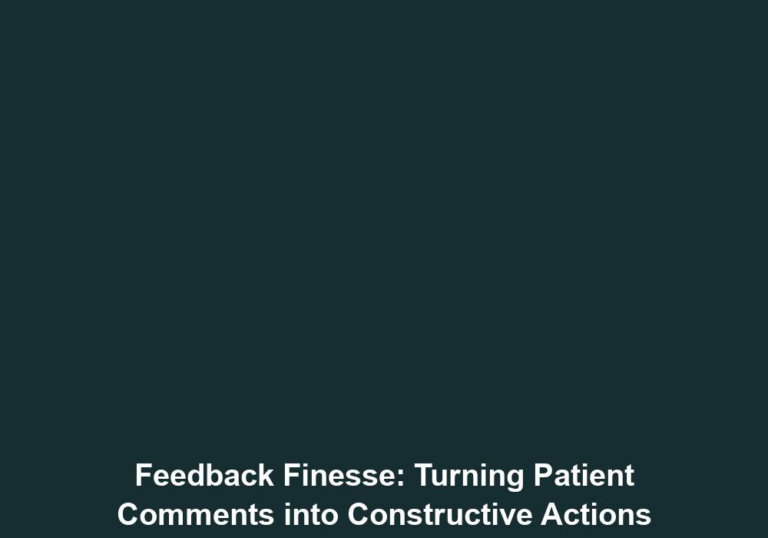From Words to Wisdom: Building a Constructive Feedback Loop in Healthcare
In the ever-evolving field of healthcare, effective communication and feedback play a crucial role in improving patient outcomes, enhancing the overall quality of care, and fostering professional growth among healthcare providers. A well-established feedback loop can transform mere words into wisdom, enabling continuous learning and improvement within the healthcare system.
The Importance of Constructive Feedback in Healthcare
Constructive feedback serves as a powerful tool for healthcare professionals to identify areas for improvement, acknowledge strengths, and enhance patient care. It promotes a culture of continuous learning, where feedback becomes a catalyst for growth and development rather than a source of judgment or criticism.
Benefits of a Constructive Feedback Loop
- Enhanced Patient Outcomes: By providing constructive feedback, healthcare professionals can identify and rectify any potential gaps in patient care, leading to improved outcomes and patient satisfaction.
- Constructive feedback enables healthcare providers to identify any deficiencies in their patient care practices and make necessary improvements.
- It helps in recognizing patterns or trends that may be affecting patient outcomes and allows for targeted interventions.
- By implementing feedback-driven improvements, healthcare professionals can enhance the overall quality of care, leading to better patient outcomes.
- Professional Development: Feedback offers healthcare providers an opportunity to reflect on their practices, learn from their experiences, and enhance their skills and knowledge. It helps them identify their strengths and weaknesses, facilitating targeted development initiatives.
- Through feedback, healthcare professionals can gain insights into their performance and areas for improvement.
- It allows for self-reflection and self-assessment, enabling professionals to recognize their own strengths and weaknesses.
- By utilizing feedback for professional development, healthcare providers can continuously improve their skills, knowledge, and expertise.
- Collaborative Learning: A well-established feedback loop encourages collaboration and knowledge sharing among healthcare professionals. It fosters an environment where teams can learn from each other’s experiences and insights, collectively improving the quality of care provided.
- Feedback promotes a culture of collaboration, where healthcare professionals can share their knowledge and experiences for the benefit of the entire team.
- It encourages interdisciplinary collaboration, enabling healthcare providers from different specialties to learn from each other’s perspectives.
- By fostering collaborative learning, a feedback loop enhances the collective expertise of healthcare professionals, leading to improved patient care.
Building an Effective Feedback Loop in Healthcare
To maximize the benefits of constructive feedback, healthcare organizations and professionals must implement a structured feedback loop. Here are some key steps to building an effective feedback loop in healthcare:
1. Create a Culture of Open Communication
Establishing a culture that encourages open communication is essential for fostering a constructive feedback loop. Healthcare professionals should feel comfortable sharing their observations, concerns, and suggestions without fear of retribution. This can be achieved through regular team meetings, open-door policies, and the promotion of psychological safety.
- Regular team meetings provide a platform for healthcare professionals to openly communicate their feedback and suggestions.
- An open-door policy ensures that healthcare providers can approach their superiors or colleagues with any concerns or feedback they may have.
- Promoting psychological safety creates an environment where individuals feel safe to share their thoughts and ideas without fear of judgment or negative consequences.
2. Train Healthcare Professionals on Giving and Receiving Feedback
Effective feedback requires both the giver and the receiver to possess certain skills. Healthcare organizations should invest in training programs that equip their professionals with the necessary skills to deliver constructive feedback in a respectful and supportive manner. Similarly, training on receiving feedback gracefully can help professionals understand the value of feedback and utilize it for self-improvement.
- Training programs can teach healthcare professionals how to provide feedback in a constructive and non-threatening manner.
- Professionals can learn techniques for delivering feedback that focuses on specific behaviors or actions rather than personal criticism.
- Training on receiving feedback helps individuals develop the ability to accept feedback gracefully, understand its value, and use it constructively for self-improvement.
3. Utilize Multiple Feedback Channels
To ensure a comprehensive feedback loop, healthcare organizations should provide multiple channels for feedback. These may include regular performance evaluations, anonymous suggestion boxes, online feedback forms, or even dedicated feedback sessions. By diversifying feedback channels, organizations can capture a wide range of perspectives and obtain a holistic view of the healthcare system.
- Regular performance evaluations allow for structured feedback on individual performance, providing an opportunity for improvement.
- Anonymous suggestion boxes provide an avenue for individuals to share feedback without fear of reprisal, promoting honest and open communication.
- Online feedback forms or dedicated feedback sessions can reach a larger audience and facilitate feedback collection on various aspects of the healthcare system.
4. Promote Timely and Specific Feedback
Feedback should be timely, specific, and actionable. Delayed feedback may lose its impact, while vague feedback may not provide sufficient guidance for improvement. It is crucial to provide feedback promptly after an event or observation, offering specific examples and actionable suggestions for improvement.
- Timely feedback ensures that healthcare professionals can address issues while they are still fresh in their minds, increasing the likelihood of meaningful improvement.
- Specific feedback provides clear guidance on what needs to be improved, allowing professionals to focus their efforts and resources effectively.
- Actionable feedback includes suggestions or recommendations that can be implemented to bring about positive change, driving continuous improvement.
5. Encourage Self-Reflection and Self-Assessment
Healthcare professionals should be encouraged to engage in self-reflection and self-assessment. This introspective practice allows individuals to recognize their own strengths and weaknesses, facilitating a proactive approach to seeking and implementing feedback. Self-reflection also helps in identifying patterns and trends in one’s performance, leading to targeted improvements.
- Self-reflection enables healthcare professionals to assess their own performance, identify areas for growth, and proactively seek feedback to address those areas.
- It allows individuals to recognize their strengths and leverage them while actively working on areas that require improvement.
- By encouraging self-reflection and self-assessment, healthcare organizations empower professionals to take ownership of their development and actively seek opportunities for growth.
6. Establish Feedback Review Mechanisms
Feedback review mechanisms help ensure that feedback is not only provided but also acted upon. It is essential to establish processes that allow healthcare professionals to review and respond to feedback received. This fosters accountability and emphasizes the importance of feedback as a catalyst for improvement.
- Feedback review mechanisms enable healthcare professionals to analyze the feedback they receive, identify common themes, and develop action plans for improvement.
- They create a feedback loop within the feedback loop, ensuring that feedback is not only received but also actively utilized for professional growth and development.
- By establishing feedback review mechanisms, healthcare organizations demonstrate their commitment to continuous improvement and encourage a culture of accountability.
7. Monitor and Measure the Impact of Feedback
Healthcare organizations should continuously monitor and measure the impact of feedback on patient outcomes, team performance, and individual development. By analyzing the data collected, organizations can identify trends, gaps, and areas of improvement, leading to targeted interventions and enhanced results.
- Monitoring the impact of feedback allows healthcare organizations to assess the effectiveness of their feedback loop and make necessary adjustments.
- By measuring patient outcomes, organizations can determine if feedback-driven improvements have resulted in better care and increased satisfaction.
- Analyzing team performance and individual development helps identify strengths, weaknesses, and opportunities for growth, enabling targeted interventions and professional advancement.
Conclusion
In the dynamic field of healthcare, a constructive feedback loop is crucial for driving continuous improvement and fostering professional growth. By creating a culture of open communication, training healthcare professionals on giving and receiving feedback, utilizing multiple feedback channels, and promoting timely and specific feedback, healthcare organizations can transform words into wisdom. Through a well-established feedback loop, the healthcare system can evolve, delivering optimal care and better outcomes for patients.


